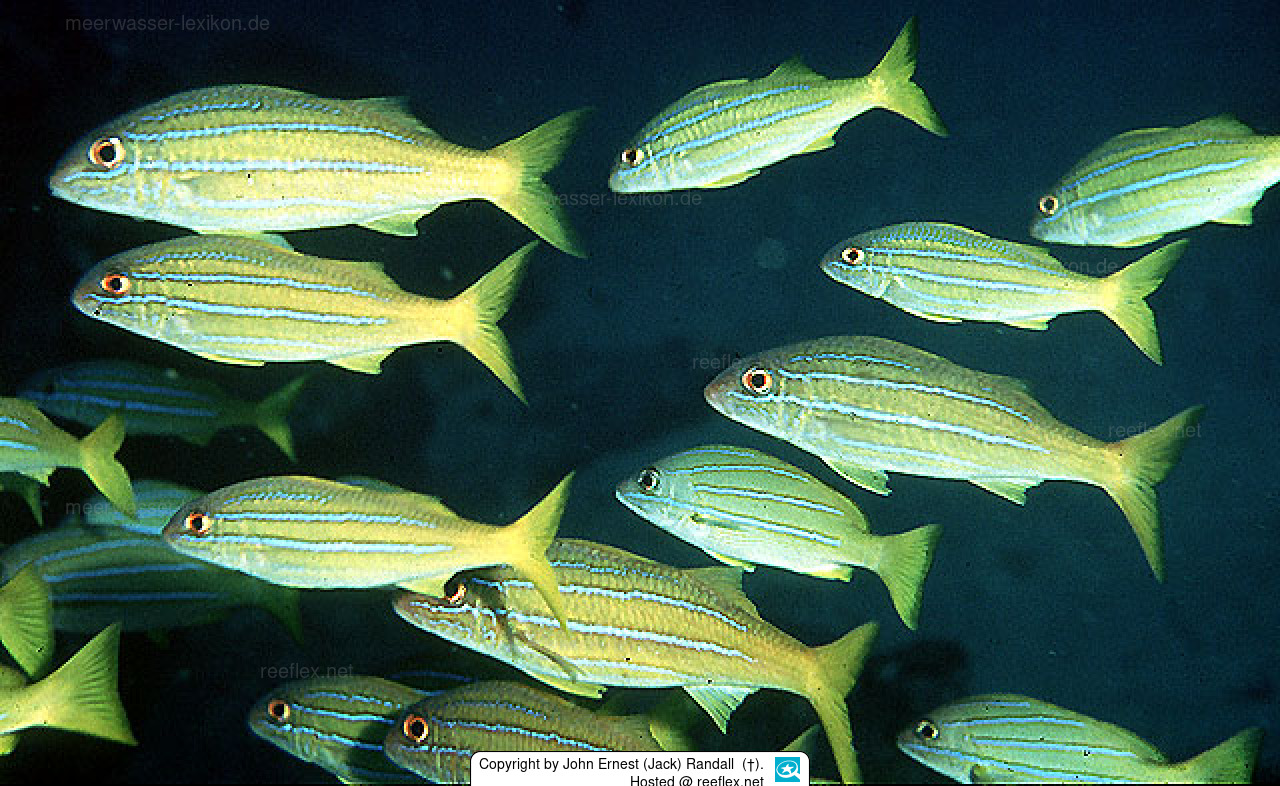Info
Mulloidichthys mimicus mimics the azure-striped snapper Lutjanus kasmira and may associate with this species during the day, so it can be difficult to accurately distinguish both species.
A similar behavior can be observed in the western Atlantic between Mulloidichthys martinicus and the yellowtail snapper (Ocyurus chrysurus (Bloch, 1791)) in the form of feeding communities.
The question arises as to why such mimicry behavior occurs and whether the mimicry only benefits one of the two species.
There are different types of mimicry:
Müllerian mimicry
Batesian mimicry
Mertensian mimicry
Vavilovian mimicry
- Peckhamian mimicry
Müllerian mimicry is a form of biological similarity in which a harmful or dangerous organism (the model), which is equipped with a warning system such as a conspicuous coloration, is imitated by a harmless organism (the mime).
The mime is protected because predators mistake it for the model and therefore leave it alone.
Batesian mimicry occurs when a species mimics the warning signals of another species without possessing the features that make it undesirable to the common predator.
Mertensian mimicry explains the deceptive similarity in coloration and size between highly venomous (S2) and less venomous (S1) species of true and false coral snakes (Elapidae and Colubridae) as an imitation of S1 by S2.
Vavilovian mimicry (also plant mimicry or weed mimicry) is a form of mimicry in plants in which a weed develops to share one or more characteristics with a domesticated plant over generations of artificial selection.
Thus, the weed receives protection against being uprooted and its seeds are spread by humans.
Peckhamian mimicry involves the deliberate attraction of living creatures in order to eat them.
It is named after the researchers George Peckham and Elizabeth Peckham. Peckhamian mimicry is also referred to as “aggressive mimicry”.
This aggressive mimicry, attack mimicry, is the imitation of special signals (visual, acoustic, olfactory and ethological signals of a non-predatory animal, a potential mating partner or a prey animal) by predators or parasites. This reduces the escape distance of the prey and makes it easier for the predator to approach.
What is the advantage for the snappers?
Studies have shown that snappers that follow the red mullets, which dig in the ground, catch a significantly higher amount of food than without the red mullets.
The barbels find additional protection by enlarging the shoals and visually adapting to the snappers, which are “known” as predatory fish.
A similar behavior can be observed in the western Atlantic between Mulloidichthys martinicus and the yellowtail snapper (Ocyurus chrysurus (Bloch, 1791)) in the form of feeding communities.
The question arises as to why such mimicry behavior occurs and whether the mimicry only benefits one of the two species.
There are different types of mimicry:
Müllerian mimicry
Batesian mimicry
Mertensian mimicry
Vavilovian mimicry
- Peckhamian mimicry
Müllerian mimicry is a form of biological similarity in which a harmful or dangerous organism (the model), which is equipped with a warning system such as a conspicuous coloration, is imitated by a harmless organism (the mime).
The mime is protected because predators mistake it for the model and therefore leave it alone.
Batesian mimicry occurs when a species mimics the warning signals of another species without possessing the features that make it undesirable to the common predator.
Mertensian mimicry explains the deceptive similarity in coloration and size between highly venomous (S2) and less venomous (S1) species of true and false coral snakes (Elapidae and Colubridae) as an imitation of S1 by S2.
Vavilovian mimicry (also plant mimicry or weed mimicry) is a form of mimicry in plants in which a weed develops to share one or more characteristics with a domesticated plant over generations of artificial selection.
Thus, the weed receives protection against being uprooted and its seeds are spread by humans.
Peckhamian mimicry involves the deliberate attraction of living creatures in order to eat them.
It is named after the researchers George Peckham and Elizabeth Peckham. Peckhamian mimicry is also referred to as “aggressive mimicry”.
This aggressive mimicry, attack mimicry, is the imitation of special signals (visual, acoustic, olfactory and ethological signals of a non-predatory animal, a potential mating partner or a prey animal) by predators or parasites. This reduces the escape distance of the prey and makes it easier for the predator to approach.
What is the advantage for the snappers?
Studies have shown that snappers that follow the red mullets, which dig in the ground, catch a significantly higher amount of food than without the red mullets.
The barbels find additional protection by enlarging the shoals and visually adapting to the snappers, which are “known” as predatory fish.







 Dr. John Ernest (Jack) Randall (†), Hawaii
Dr. John Ernest (Jack) Randall (†), Hawaii









